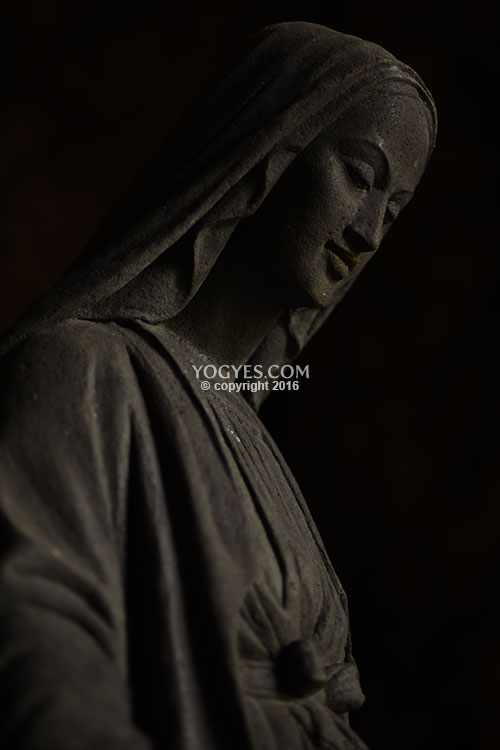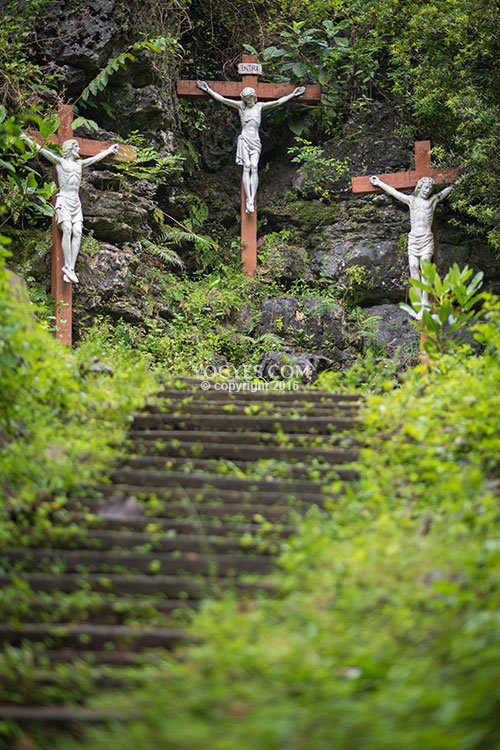

GUA MARIA TRITIS
Oase Batin di Bukit Gersang
Gua Maria Tritis merupakan salah satu gua alami yang ada di deretan perbukitan karst Gunungkidul dan dijadikan sebagai tempat peziarahan umat Katholik. Dinamakan Tritis karena selalu ada air yang menetes(tumaritis) dari stalaktit yang ada di langit-langit gua. Pada mulanya gua ini merupakan tempat yang sepi dan angker sehingga tidak banyak orang yang berani memasukinya. Oleh karena itu, gua ini sering dijadikan sebagai tempat pertapaan dan menjadi tempat persinggahan beberapa pangeran dari Kerajaan Mataram. Gua ini mulai dikenal oleh umat Katholik pada tahun 1974, yakni pada saat digunakan sebagai tempat Ekaristi Natal. Mulai saat itu Gua Tritis diberi tambahan nama Maria dan menjadi tempat favorit para peziarah.
Untuk mencapai gua, peziarah harus berjalan kaki membelah ladang jati, melewati jalan setapak yang berkelok di antara bukit-bukit karang yang tandus. Ada dua pilihan rute untuk mencapai lokasi Gua Maria Tritis, yakni rute panjang sekitar 1,5 km dan rute pendek sejauh 500 meter. Peziarah yang melakukan jalan salib biasanya melewati rute panjang dengan 14 stasi pemberhentian yang dilengkapi diorama kisah sengsara Yesus. Pada stasi ke 12 dibangun 3 buah salib di bawah bukit yang menggambarkan penyaliban Yesus bersama 2 orang penjahat.
Hari menjelang senja tatkala YogYES tiba di parkiran Gua Maria Tritis. Suasana begitu sunyi dan hening, hanya ada derik serangga dan sesekali hembusan angin yang bergesekan dengan daun-daun jati. Bergegas YogYES berjalan menyusuri jalan batu yang membentang di depan. Setelah melawati stasi demi stasi, relung gua yang dihiasi stalaktit dan stalagmit menyambut. Sebuah patung Maria yang sedang berdoa berukuran besar diletakkan di salah satu sudut. Altar perjamuan kudus yang terbuat dari batu alam berhiaskan aneka bunga terlihat di tengah gua. Sedangkan tempat duduk umat hanya berupa hamparan karpet. Nuansa alami dan sederhana begitu terasa di gua ini.
Saat bulan Mei dan Oktober, Gua Maria Tritis ramai dikunjungi peziarah sebab bulan-bulan tersebut merupakan bulan Maria. Sedangkan bagi peziarah yang ingin mengikuti ibadah Novena di gua ini dapat datang pada minggu pertama di tiap bulannya. Mentari sudah kembali ke peraduannya saat saya bersimpuh di depan patung Maria. Pendar lilin yang bergoyang tertiup angin seolah memberi petunjuk bahwa masih ada harapan di tengah gelap dan carut-marutnya keadaan dunia. Bunyi air yang menetes dari beberapa stalaktit menjadi melodi indah yang mengiringi permenungan diri, ada damai yang menelusup di relung hati.
Tidak ada komentar:
Posting Komentar